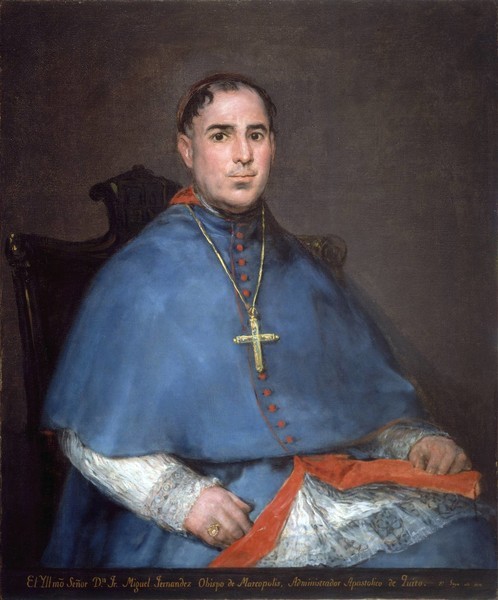- Cronología
- 1815
- Ubicación
- Worcester Art Museum, Worcester, United States
- Dimensiones
- 100 x 84 cm
- Técnica y soporte
- Oil on canvas
- Reconocimiento de la autoría de Goya
- Documented work
- Titular
- Worcester Art Museum
- Ficha: realización/revisión
- 18 Apr 2010 / 16 Jun 2023
- Inventario
- (1911.25)
El Yllmõ Señor D.n Fr. Miguel Fernandez Obispo de Marcopolis, Administrador Apostolico de Quito. P.r Goya año 1815 ("The Most Illustrious Señor Don Friar Miguel Fernández, Bishop of Marcópolis, Apostolic Administrator of Quito. By Goya, 1815", at the bottom)
Goya was almost certainly commissioned to paint this portrait to commemorate the sitter being named Apostolic Administrator of Quito, as the inscription states. Given the connection to the Spanish colonies, Ignacio Omulryan, minister of the Council of Indies, whom Goya had also painted, may have acted as mediator between the subject and the artist.
The work remained in the possession of the sitter, in Seville. It later entered the collection of the painter Vivaldi, also in Seville, and then went to that of Enrique Salazar, again in Seville, and that of the Marquis of La Vega Inclán, in Madrid. In entered the Worcester Art Museum in 1911.
Friar Miguel Fernández Flores (Bujalance, Córdoba, 1764-Seville, 1822) was named auxiliary bishop of the prelature of Quito in 1814. In 1815, he was named bishop in partibus of Marcópolis and, immediately afterwards, Apostolic Administrator of Quito. In 1816 he was appointed Bishop of Quito, but despite his strong ties to the country, there is no evidence that he ever visited Ecuador. After his career as cleric, he became the domestic bishop of the king's council.
Here he is depicted with all the pomp and splendour that befits his position. Following the tradition of papal portraits, the portrait is half-length, showing him seated in an imposing seat of honour and dressed in his bishop's suit, sky blue with red lining and buttons, and white lace on the alb. Standing out on his right hand, which is resting in his lap, is a large gold ring, and around his neck hangs a large gold cross. He is facing forwards, his body forming a clear triangular shape, at the top of which is his head, standing out against a neutral background. His face, painted with a marked verism, looks out at the viewer with an attentive gaze, as if the Franciscan were drawing us in to the portrait's creative process.
-
GoyaMuseo Nacional de ArteMexico D.F.2005
-
Goya en tiempos de guerraMuseo Nacional del PradoMadrid2008consultant editor Manuela B. Mena Marqués, from April 14th to July 13th 2008cat. 163
-
Goya: Order and disorderMuseum of Fine ArtsBoston2014cat. 151
-
L'œuvre peint de Goya. 4 volsParís1928-1950vol. II, p. 163, cat. 450
-
Goya and his sittersNew YorkThe Hispanic Society of America1964pp. 40-41
-
Vie et ouvre de Francisco de GoyaParísOffice du livre1970pp. 297, 376, cat. 1548
-
BarcelonaPolígrafa1970vol I, p. 364, cat. 642
-
L’opera pittorica completa di GoyaMilanRizzoli1974p. 129, cat. 583
-
Francisco de Goya, 4 vols.ZaragozaCaja de Ahorros de Zaragoza, Aragón y Rioja1980-1982vol. IV, p. 43
-
Goya en tiempos de guerraMadridMuseo Nacional del Prado2008p. 448, cat. 162 y p. 449 (il.)
-
Goya: Order & DisorderBostonMuseum of Fine Arts Boston Publications2014pp. 232- 239
